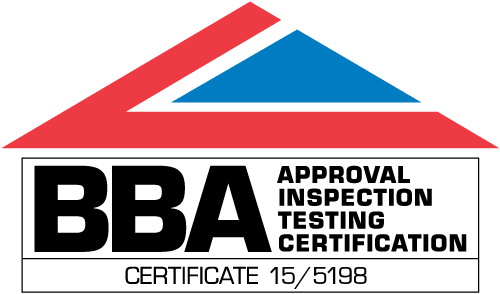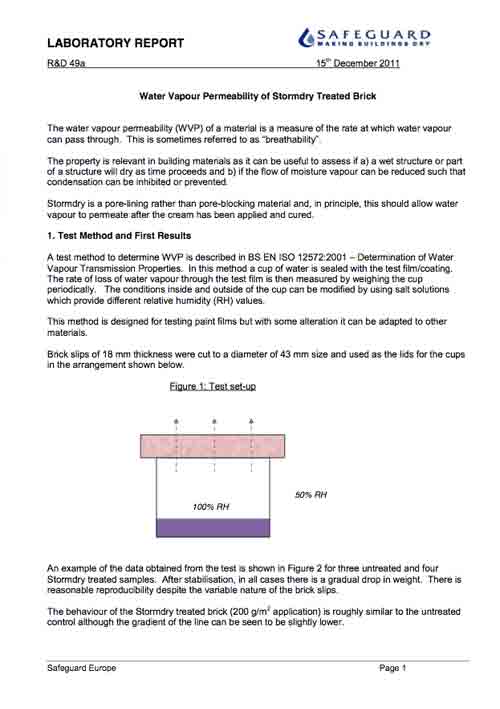Water Vapour Permeability of Stormdry Treated Brick
This was a laboratory test carried out by the research & development department at Safeguard Europe in 2011.
Test Aims
After previous testing, it was known that Stormdry is effective at protecting masonry from liquid water penetration. Seeing as Stormdry is a pore-lining masonry water proofer, as opposed to a pore-blocking water proofer, it was surmised that a wall or surface treated with Stormdry would still allow water vapour to pass through it. The research and development laboratory was tasked with finding out to what extent this is true and to compare the results with other methods of exterior wall weather protection.
Test Method
It was decided to use the British Standard test for determining the extent of water vapour permeability through a material (BS EN ISO 12572:2001 – Determination of Water Vapour Transmission Properties). Individual cups of water were capped with 18mm thick by 43mm diameter brick slips. For the first batch of tests there were 3 untreated control slips and 4 Stormdry treated slips.
The relative humidity inside the cups was 100% and the external relative humidity was kept as close to 50% as possible, meaning that the water vapour would want to move from an area of high concentration to an area of low concentration. The permeability of each brick slip would affect how quickly this would happen. The cups were initially weighed and then vapour loss from inside the cups was tracked by weighing them again at specific time intervals.
For the second batch of tests, each brick slip was treated with different combinations of coatings. Those combinations were as follows:
- No treatment
- Urethane clear coating
- Dulux Weathershield paint
- Stormdry
- Stormdry + Dulux Weathershield
The only difference in process between the first batch of tests and the second batch was that the second batch of tests were performed twice, once at 50% external humidity and once at 80% external humidity.
Results
The results of the first batch of tests showed that Stormdry was, on average, 90% as permeable as completely untreated brick slips. The average vapour loss for the untreated control brick slips was 90g/m²/per day, compared to the brick slips treated with Stormdry, which lost 81g/m²/per day. The consistency of the results showed that there is a reasonable level of reproducibility, despite the sometimes variable nature of the brick slips.
The results of the second batch of tests showed that Stormdry had, by far, the least intrusive effect on breathability, when compared to the alternative methods of water proofing. The results, for each different water proofing method, when compared to the untreated brick slips, were:
- Stormdry – 90% as breathable
- Dulux Weathershield – 58% as breathable
- Stormdry + Dulux Weathershield – 56% as breathable
- Urethane clear coating – 36% as breathable
The results remained proportionally similar for all tests, regardless of whether the external relative humidity was 80% or 50% but more water vapour passed overall, when there was a greater difference between the internal and external humidity.
Conclusion
As the results show, Stormdry has an almost negligible effect on the breathability of a substrate. This means that a user of Stormdry can be assured that their property will be protected from water penetration, without compromising the breathability of the surface to which it is applied. This is an advantage in certain situations, such as:
Allowing previously saturated walls to dry out whilst preventing further water penetration, meaning Stormdry can be applied, within reason, to already damp walls.
Protecting properties from condensation, mould growth or rot, by allowing water vapour to diffuse from the interior to the exterior, without getting trapped by a non-breathable weather proofing layer.
Providing extra protection, when applying underneath water based masonry paint, helping to achieve the desired finish without further reducing vapour permeability.
These factors further confirm that Stormdry is the most effective, and least intrusive, masonry water proofer on the market.


